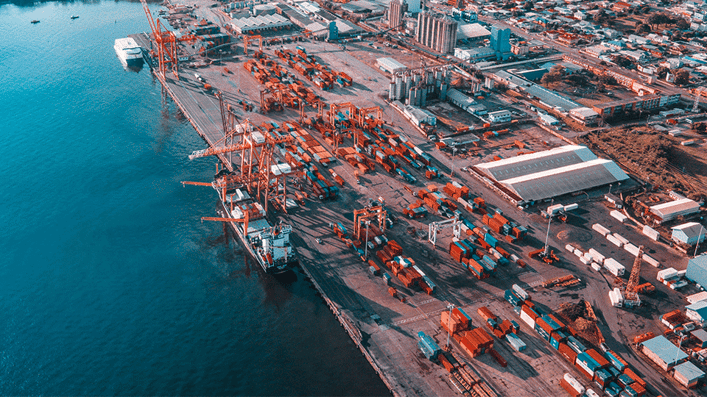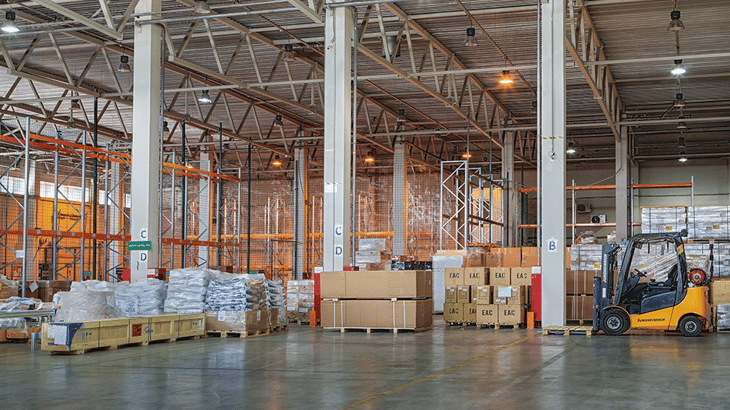- Bonded shipment definition
- How bonded shipping works
- Bonded carrier definition
- Bonded warehouse definition
- Documents needed to ship in-bond
- Types of freight that can be shipped in-bond
Moving freight in-bond across the U.S. can be a difficult process to get right — especially without a well-rounded understanding of how this is done.
To this point, you’ve likely felt confused about how to properly bond your shipment as the international transportation landscape is riddled with complexity.
Here at Anderson Trucking Service (ATS), we understand the predicament you’re in; without a great transportation partner, it’s not uncommon to feel overwhelmed by bonded transportation. That doesn’t mean you can’t get this right, though. After nearly seven decades in the transportation sphere, we’ve helped many shippers in this same predicament before.
In this article, we’ve outlined the major aspects of bonded shipping so you can ensure to do this correctly when it’s time to get your next load moving.
To avoid prolonged delays, unnecessary costs and, in the worst case, a failed shipment altogether, these are crucial understandings. Let’s talk about them.
What is a Bonded Shipment?
A bonded shipment is a shipment that reaches its final destination country by way of one or more ancillary countries. Since it won’t be consumed or used in any of the countries traversed along the way, bonded cargo doesn’t officially undergo customs clearance until it reaches its destination country.
As a result, all taxes, duties and fees associated with a bonded shipment’s import are delayed until its terminal arrival. When arranged properly, shipping cargo in-bond helps companies ensure that their international goods are routed appropriately and aren’t “released” until they reach their final location — which can sometimes force them to pay duties and taxes multiple times.
Though there are a variety of situations where bonding a shipment makes sense, this is most commonly done when freight needs to be transported through the U.S. with plans to eventually move along to a foreign country.

How Does Bonded Shipping Work?
To ship in-bond through the U.S., each shipment must have the proper arrangements and paperwork. Two things must be accomplished before a shipment leaves its country of export:
- Booking a bonded carrier and/or warehouse
- Completing proper documentation
Booking a Bonded Carrier
In order to ship cargo in-bond across the U.S., you’ll need to locate and secure capacity from a bonded carrier. Should your cargo need warehousing services during transit, a bonded warehouse must also be used.
Although working with a customs broker and/or a competent freight forwarder will help expedite these arrangements, here’s what you should know about each of them.
What is a Bonded Carrier?
A bonded carrier is a transportation provider that is licensed to move freight through/across U.S. points of entry (ports, border crossings) without having to pay duties, taxes and/or fees on those goods during that specific portion of their transportation.
Utilizing a licensed bonded carrier allows an importer and/or consignee to transport cargo pending customs clearance until it reaches the port of entry at its destination country.
To obtain an international carrier bond, trucking companies must reach out to a surety company that has been approved by the CBP. With their help, carriers complete CBP Form 301, supplying all pertinent information to secure either a “single transaction” or “continuous” customs bond.
For the most part, when shipping a load that originates in Canada or Mexico across the U.S. in-bond, the bonded carriers used also have international authority — allowing them to cross the border and legally operate in multiple countries.
What is a Bonded Warehouse?
A bonded warehouse is a legally authorized building or secured area where cargo — which will eventually be transported to a foreign country for consumption/utilization — can be housed, handled and/or manufactured without having to pay U.S. customs duties and taxes during its duration at that warehouse.

By and large, bonded warehouses are managed by either a private party (in which situation a customs bond is required) or the U.S. government.
Documentation Needed For Bonded Freight Transport
The main documents that are often required to ship a load “in-bond” include:
- In-bond application
- Customs Bond
- CBP Form 7512
- Commercial invoice
- Bill of lading
- Packing list
What is an In-Bond Application?
An in-bond application is a comprehensive outline of shipment information and transit details that must be submitted to the CBP via an approved electronic data interchange (EDI).
Every in-bond application submitted to the CBP must include the following information:
- A description of the merchandise/commodity in transit
- The commodity’s six-digit Harmonized Tariff Schedule (HTS) code
- Cargo quantities
- Container seals and number, when applicable
- Cargo destination within the U.S.
- Any additional identifying information for the shipment, such as entry numbers, visas, or licenses issued by the U.S. or foreign government(s)
What Is a Customs Bond?
A customs bond is a contract held between the principal importer or shipper of a product, a Surety company and the U.S. Customs and Border Protection (CBP) agency. Through the issuance of a line of credit — from a Surety company to the U.S. government — customs bonds contractually ensure that the principal party responsible for paying for the freight pays all taxes and duties at the appropriate time.
Without a customs bond in place, no shipment can enter the U.S. as these documents protect the CBP in the event that duties and taxes aren’t paid.
In order to successfully ship cargo in-bond, the shipper (seller) and importer (buyer) must have a cargo bond in place as well as a commercial invoice, bill of lading and packing list.
What is CBP Form 7512?
This document, which is crucial to bonded cargo transportation, outlines:
- When freight will enter the U.S.
- Where it will enter the U.S.
- How freight will reach its final destination
- Who the consignee of all goods are
- Which foreign ports/entrances it will interact with
- Estimated departure/export dates
Here is a copy of the CBP Form 7512 for your reference.
What is a Commercial Invoice?
Commercial invoices are a shipment’s bill of sale. Your shipment’s commercial invoice should include the following information:
- Seller/shipper information
- Buyer information
- Declared value of commodity
- Commodity description with its HTS code
What is a Bill of Lading?
Bill of lading forms document freight services and outline a shipment’s journey, complete with information such as how freight will be transported, the names and contact information of all parties (consignee, carrier, freight forwarder, etc.).
Depending on your cargo’s mode of transportation, the format of its bill of lading will change.
What is a Packing List?
Your packing list should outline information specific to the cargo in transit. This includes the specific commodity in transit, its final destination and the dimensions/quantities of each item. This will help U.S. customs officials understand where their duties lie in relation to your products.
Related: What Documents Are Required For International Shipping?
What Kind of Cargo Can Be Shipped In-Bond?
When accompanied by the proper documentation, the vast majority of cargo can be shipped in-bond throughout the U.S.
This includes containerized cargo (transported via chassis), open deck and dry van freight and products that arrived via roll-on/roll-off or breakbulk ocean transport. To help you make arrangements for your next in-bond shipment it’s important that you work with a transportation provider that has experience in this area.
Related: The Pros and Cons of Using a Freight Forwarder (+ How to Choose Yours)
Learn More About the Cost of International Shipping
With an understanding of what bonded shipments are, how this process should be arranged and what kind of cargo you can realistically ship, we hope you’re a bit more comfortable now.
For what it's worth, shipping a load in-bond doesn’t need to fill you with dread. You can get this right.
Another question we’re commonly asked is “What will this cost me?”
If you have similar concerns and would like some more information on how international freight rates are calculated, check out this article.
Or, if you’d like an exact price for your next bonded shipment, calculated to get your shipment moved without a hitch, reach out to us today.






